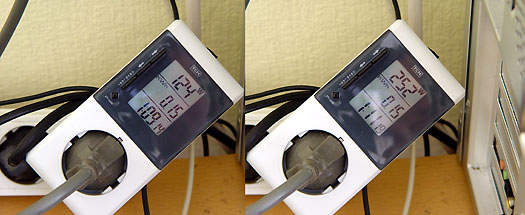Page 3
Installation
Installing the processor was of course easy as counting one two three. We made use of a Gigabyte K8NXP SLI mainboard to test the processor. You mount the CPU on the mainboard, apply the heatsink. Clear your BIOS CMOS (not necessary but I always do recommend it). And simply boot up or install windows (or whatever preferred operating system).
I almost immediately start checking the processor temperature after a new installation, just to make sure all is installed well, in specific I recommend you to always do this so you can see if the fan was installed properly. Just after the windows boot the CPU Temperature was 30.0°C / 86.0°F. With a 100% CPU load it reached 55 Degrees C. That's really good, we can now continue.
AMD's Athlon 64 4000+ processor doesn't really bring anything new to the table in terms of features besides if you did not have it yet, 64-bit compatibility. Two features though are heavily marketed. AMD's Cool N' Quiet and Enhanced Virus Protection.
Cool N' Quiet is a noise and power saving technology which allows the CPU to dynamically throttle its speed along with a thermally controlled heatsink fan. These adjustments are made based on the current CPU load and when we checked, active and working:
Enhanced Virus Protection is a new technology exclusive to the Athlon 64 CPU. It is designed to halt certain virus and exploit attacks as they occur. Enhanced Virus Protection works together with Microsoft's DEP (Data Execution Prevention) code introduced in Service Pack 2 for Windows XP. When enabled (by using a compatible processor like the Athlon 64 4000+) the operating system watches for certain anomalies that often suggest a virus or exploit hit, like code being executed in memory spaces where program code is not supposed to be.Processor Power Management
Processor Throttling Enabled : Yes
Throttle Range : 12% - 100%
Next to these two newer technologies the CPU of course supports the standard Athlon 64 feature list including SSE2, a 1000MHz (up and down stream) Hypertransport link to motherboard, integrated dual channel memory controller, 8 extra 64-bit registers and so on...
I Demand Powerrrr![]()
What you also need to realize is you will likely require a new higher-powered power supply if you are building a high-end PC.
The CPU alone can roughly use 100 Watts of power.
The power draw was relatively low though. With this Athlon 64 4000+ based system with two HD's, a DVD-Rom, 512 MB memory and GeForce 6 6800 GT in-game the PC pulled a maximum of 260 Watt. You need some reserve though. So don't go thinking that a 300 Watt PSU is sufficient, be smart start at 350 Watts as bare minimum. Btw and before you go thinking, yeah right how on earth does he know that. Simple we have a Wattage meter between the PC and the power outlet.
To your left the PC in idle, to your right 3DMark05 is running and power usage is slowly maxing out.
Enough technical chit-chat, let's have a look how well this little beast actually performs and how it looks in our photo-shoot.
